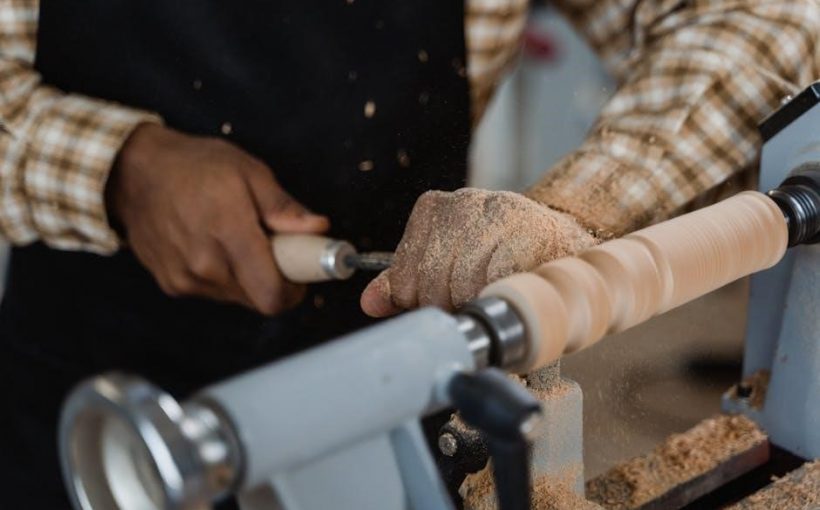A manual lathe is a versatile machining tool used for shaping metal‚ wood‚ and plastic by rotating the workpiece against cutting tools. Historically‚ lathes have evolved from basic woodworking tools to precision instruments in modern manufacturing‚ offering unparalleled control for craftsmen and industries alike.
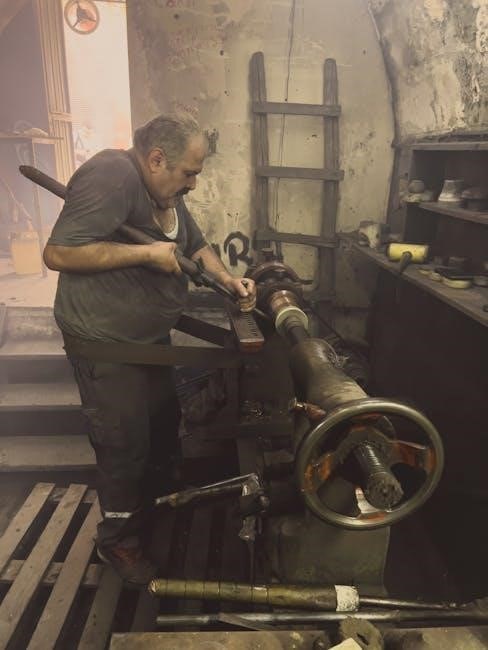
What is a Manual Lathe?
A manual lathe is a machine tool designed for shaping and machining materials like metal‚ wood‚ and plastic. It operates by rotating the workpiece around a central axis while applying cutting tools to achieve desired shapes. Unlike CNC lathes‚ manual lathes rely on operator control for precision and accuracy. Key components include the bed‚ headstock‚ tailstock‚ and spindle‚ which work together to support and rotate the workpiece. Manual lathes are widely used in workshops‚ schools‚ and small manufacturing setups for tasks like turning‚ facing‚ and threading‚ offering versatility and hands-on craftsmanship.
Historical Background of Manual Lathes
Manual lathes trace their origins to ancient civilizations‚ where early bow lathes were used for woodworking. Over centuries‚ lathes evolved‚ with significant advancements during the Middle Ages. The Industrial Revolution brought mechanized lathes‚ enabling mass production. By the late 19th century‚ manual lathes gained precision with the addition of tailstocks and back gear systems. Myford lathes‚ emerging in the early 20th century‚ became iconic for their craftsmanship. Today‚ manual lathes remain essential in workshops and education‚ blending tradition with modern machining needs for precise‚ hands-on fabrication.
Importance of Manual Lathes in Modern Manufacturing
Manual lathes remain crucial in modern manufacturing for their precision and versatility. They’re ideal for small-scale production‚ prototyping‚ and custom parts. Often used in aerospace and automotive industries‚ they complement CNC machines by handling complex or low-volume tasks efficiently. Their cost-effectiveness and ability to produce high-quality finishes make them indispensable. Additionally‚ they’re essential for training future machinists‚ ensuring traditional skills aren’t lost. This blend of practicality and precision keeps manual lathes relevant in today’s manufacturing landscape.
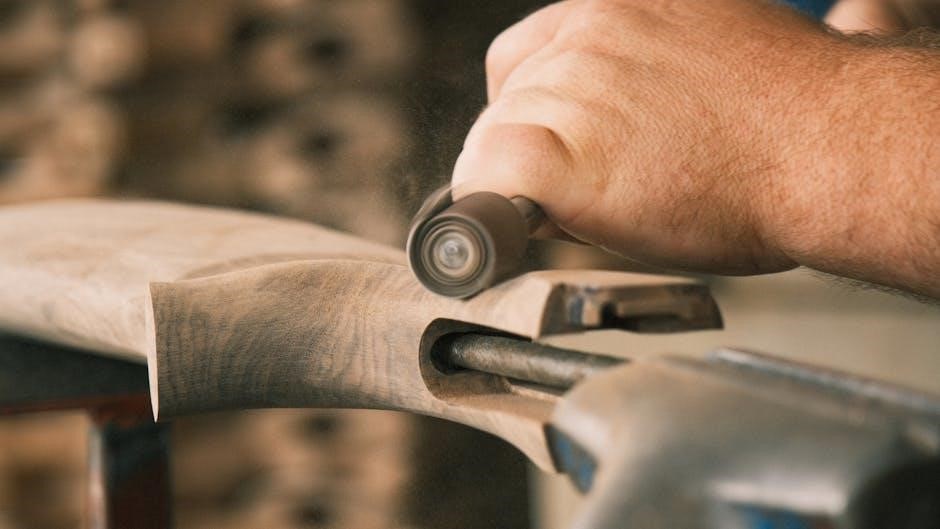
Key Components of a Manual Lathe
A manual lathe consists of a bed‚ carriage‚ headstock‚ tailstock‚ spindle‚ chuck‚ and feed mechanism. These components work together to support and shape materials with precision and control.
Bed and Carriage System
The bed is the sturdy base of the manual lathe‚ providing rigid support for all operations. It is typically made of cast iron for stability and vibration reduction. The carriage moves along the bed‚ guided by dovetail ways‚ ensuring precise lateral movement. It houses the cross-slide and compound rest‚ which position the cutting tool accurately. The bed and carriage system is crucial for maintaining alignment and enabling smooth‚ controlled machining operations‚ making it the backbone of the lathe’s functionality.
Headstock and Its Functions
The headstock is a critical component of a manual lathe‚ housing the spindle and its bearings. It is typically located at the left end of the bed and contains gears that control spindle speed. A lever selects the speed‚ while a backgear provides slower speeds for heavy cutting. The headstock’s durability and alignment are essential for precise machining‚ often constructed from cast iron for stability and longevity. Proper maintenance ensures consistent performance and accuracy in all machining operations.
Tailstock and Its Role
The tailstock is a crucial component of a manual lathe‚ positioned at the opposite end of the bed from the headstock. Its primary function is to provide additional support for the workpiece‚ particularly during operations like boring or reaming. The tailstock is equipped with a rotating center that aligns with the spindle‚ ensuring concentricity. Adjustments can be made to accommodate varying workpiece lengths. Proper alignment and locking of the tailstock are essential for maintaining accuracy and preventing workpiece deflection during machining operations‚ ensuring smooth and precise results.
Spindle and Chuck Assembly
The spindle and chuck assembly is central to a manual lathe’s operation‚ enabling secure workpiece mounting. The spindle rotates the workpiece‚ while the chuck‚ typically a three- or four-jaw mechanism‚ holds it firmly. Various chuck types‚ such as independent or scroll models‚ offer flexibility for different materials and shapes. Proper alignment and tightening are critical to prevent vibration and ensure accurate machining. Regular maintenance of the spindle bearings and chuck jaws ensures optimal performance and longevity of the lathe‚ making it essential for precise and efficient operations.
Feed Mechanism and Gearing System
The feed mechanism and gearing system in a manual lathe control the movement of the cutting tool along the workpiece. This system allows for precise control over feed rates‚ ensuring accurate material removal. The gearing system provides various speed and torque options‚ enabling operators to adjust for different materials and operations. By engaging specific gears‚ users can achieve the desired rotational speed and linear feed rate; Proper alignment and lubrication of these components are essential for smooth operation and consistent results‚ making the feed and gearing system a critical part of the lathe’s functionality.
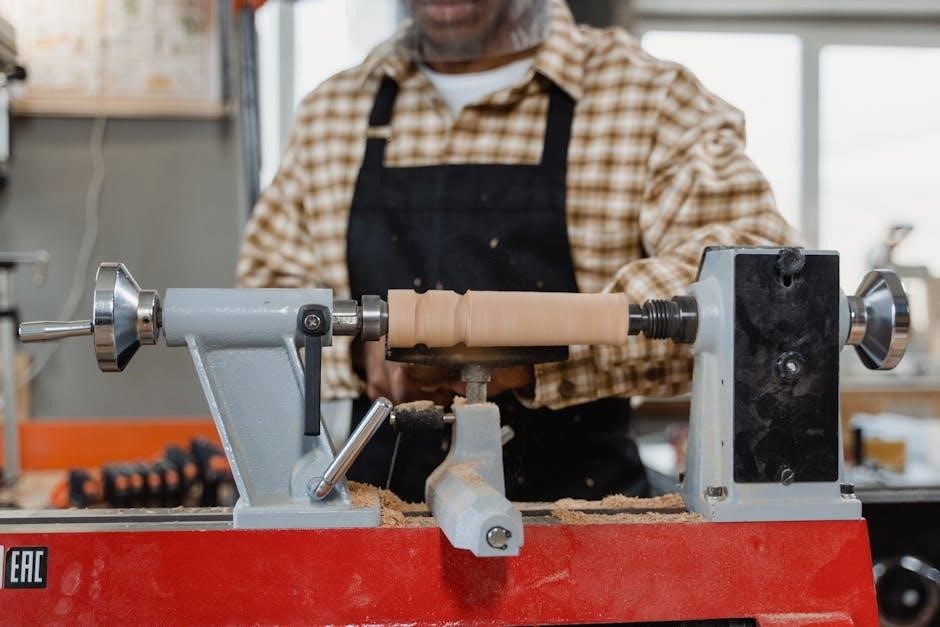
Setting Up a Manual Lathe
Setting up a manual lathe involves initial assembly‚ alignment‚ calibration for accuracy‚ securing the workpiece‚ and selecting appropriate cutting tools for precise machining operations.
Initial Assembly and Alignment
Initial assembly and alignment of a manual lathe require careful attention to ensure proper function. Start by following the manufacturer’s manual to assemble components correctly‚ ensuring the tool post is positioned at the front. Align the carriage and tailstock precisely with the bed‚ checking that the bed is level. Proper belt tension on the headstock and accurate spindle alignment are crucial for smooth operation. Ensure all mechanical parts are securely fastened and properly calibrated before use.
Calibrating the Lathe for Accuracy
Calibrating a manual lathe ensures precision and accuracy in machining operations. Begin by using a precision indicator to check the headstock and tailstock alignment‚ ensuring they are parallel and properly seated. Verify that the spindle runs true by measuring its concentricity. Adjust the gibs and carriage alignment to eliminate any play or misalignment. Finally‚ set the cutting tool height and ensure the feed rates are correctly calibrated for consistent results.
Mounting and Securing the Workpiece
Mounting and securing the workpiece on a manual lathe is critical for accurate machining. Common methods include using a three-jaw or four-jaw chuck for round and irregular shapes‚ respectively. For larger or irregular pieces‚ a faceplate with clamps or screws can be employed. The tailstock provides additional support for long workpieces‚ maintaining stability in “between centers” machining. Proper alignment and balance are essential to prevent vibration and ensure safety. Always use appropriate tools and techniques to secure the workpiece‚ considering material type and necessary clamping pressure.
Choosing the Right Cutting Tools
Selecting the appropriate cutting tools is essential for precise and safe machining on a manual lathe. Tools are typically made from high-speed steel or carbide‚ offering durability and resistance to wear. The choice depends on the material being machined‚ with carbide tools excelling for hard metals and high-speed steel suitable for softer materials. Ensure the tool’s geometry matches the operation‚ whether roughing‚ finishing‚ or facing; Proper tool angles and sharpness are critical for achieving desired results. Always refer to material specifications and tool manufacturer guidelines for optimal performance and safety.
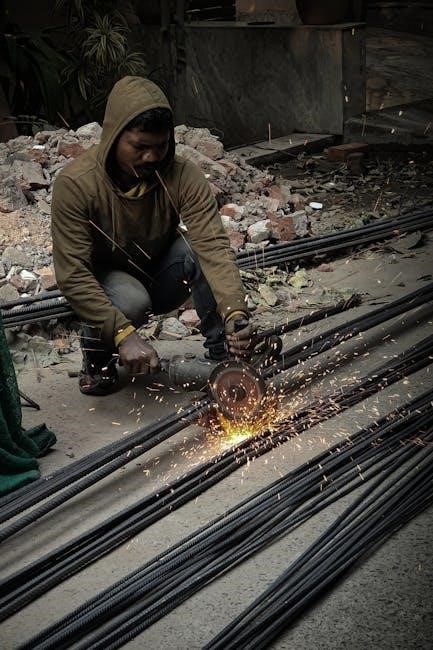
Operating a Manual Lathe
Operating a manual lathe involves precise control of the cutting tools and workpiece rotation. It requires skill and attention to achieve accurate and safe machining results consistently.
Basic Turning Operations
Basic turning operations on a manual lathe involve rotating the workpiece and moving a cutting tool along its length to shape it. This process includes facing‚ turning‚ and boring. Facing creates a flat surface on the workpiece’s end‚ while turning shapes the cylindrical surface. Boring enlarges existing holes or creates new ones. Proper setup‚ tool selection‚ and precise control ensure accurate and safe results. These operations are fundamental in manufacturing‚ requiring a steady hand and a clear understanding of the lathe’s capabilities to produce consistent‚ high-quality parts.
Facing and Boring Techniques
Facing and boring are essential techniques in manual lathe operations. Facing involves cutting a flat surface on the end of a workpiece‚ ensuring perpendicularity to the axis. Boring focuses on enlarging existing holes or creating new ones to precise diameters. Both processes require careful tool alignment and consistent cutting speeds. Proper use of facing tools and boring bars is critical for achieving accurate results. Safety precautions‚ such as using personal protective equipment and securing the workpiece‚ are paramount. These techniques are fundamental for producing parts with precise dimensions and smooth finishes‚ essential for proper fitting and assembly in manufacturing.
Thread Cutting and Tapping
Thread cutting and tapping are specialized operations on manual lathes for creating screw threads and holes. Thread cutting involves using a die or chase to shape external threads‚ while tapping uses a tap bit for internal threads. Both processes require precise alignment and control. Cutting speeds must be adjusted to avoid tool damage. Proper coolant application ensures clean cuts. These techniques are essential for mating parts in mechanical assemblies‚ offering precise fitment and functionality. Mastery of these skills enhances productivity and accuracy in manufacturing and repair tasks. Safety and tool maintenance are critical for optimal results.
Advanced Techniques for Complex Shapes
Advanced techniques on manual lathes enable the creation of intricate and asymmetrical shapes‚ such as curved or tapered geometries. These methods often involve specialized cutting tools‚ like form tools or radius tools‚ and precise control over the carriage and cross-slide. Skilled machinists can achieve complex profiles by carefully planning and executing multi-step operations. For example‚ grinding or milling attachments can be used to produce non-circular shapes. These techniques require a deep understanding of material properties and toolpath optimization to ensure accuracy and surface finish. They are invaluable for crafting custom or unique components.

Safety Considerations
Manual lathe operations require personal protective equipment‚ adherence to emergency stop procedures‚ and awareness of potential hazards to ensure a safe working environment.
Personal Protective Equipment (PPE)
When operating a manual lathe‚ wearing proper PPE is essential to prevent injuries; Safety glasses or goggles protect eyes from flying debris‚ while earplugs reduce noise exposure. A face mask can prevent inhalation of metal chips or dust. Gloves improve grip and protect hands from cuts or abrasions. Steel-toe boots or closed-toe shoes safeguard feet from heavy objects. Ensuring PPE fits correctly and is maintained properly is crucial for effectiveness. Always follow safety guidelines and industry standards like OSHA to minimize workplace risks.
Emergency Stop Procedures
In case of an emergency‚ immediately engage the manual lathe’s emergency stop button or lever to halt all operations. Locate the stop mechanism beforehand‚ as its position varies by model. Once activated‚ ensure the machine comes to a complete standstill before approaching. Turn off the power supply and carefully secure loose parts or tools. Always follow the manufacturer’s guidelines for emergency procedures to prevent accidents and ensure operator safety. Regularly test the emergency stop system to confirm its functionality and reliability.
Avoiding Common Hazards
To ensure safety while operating a manual lathe‚ always wear appropriate PPE‚ including safety glasses and gloves. Keep loose clothing and long hair tied back to avoid entanglement. Never reach near moving parts or remove metal chips by hand; use a brush instead. Maintain a clean workspace to prevent tripping hazards. Regularly inspect tools and machinery for wear or damage. Familiarize yourself with emergency stop procedures and ensure all guards are in place. Proper training and adherence to safety protocols minimizes risks‚ ensuring a secure working environment for efficient and incident-free machining.
Maintenance and Troubleshooting
Regular lubrication of moving parts and thorough cleaning ensure smooth operation; Inspect components like belts and gears for wear. Address vibrations or unusual noises promptly to prevent damage.
Regular Lubrication and Cleaning
Regular lubrication and cleaning are critical for maintaining a manual lathe’s performance. Apply oil to moving parts like gears and slides to prevent wear. Clean the bed and carriage regularly to remove debris‚ ensuring accurate cuts. Use a degreaser on the spindle and chuck‚ then wipe down with a cloth. Proper maintenance prevents rust and ensures smooth operation. Neglecting these steps can lead to premature wear‚ decreased accuracy‚ and potential machine damage. Consistent care extends the lathe’s lifespan and maintains its efficiency.
Diagnosing Common Issues
Identifying issues with a manual lathe often starts with observing unusual vibrations‚ noises‚ or inaccurate cuts. Check for misalignment by ensuring the spindle runs true and the tailstock aligns with the headstock. Inspect for worn or loose parts‚ such as spindle bearings or gib keys‚ which can cause play. Excessive tool wear or chatter may indicate improper tool setup or insufficient coolant use. Regularly inspect belts and pulleys for wear. Addressing these issues promptly prevents further damage and maintains precision. Proper diagnosis ensures efficient troubleshooting and extends the lathe’s operational life.
Replacing Worn or Damaged Parts
Replacing worn or damaged parts on a manual lathe is essential to maintain precision and functionality. Start by identifying worn components‚ such as spindle bearings‚ belts‚ or cutting tools‚ and refer to the lathe’s manual for replacement guidelines. Use genuine or compatible parts to ensure proper fitment. Clean the area before installation to prevent debris interference. Tighten all fasteners securely but avoid over-tightening‚ which can damage threads. Regular replacement of worn parts prevents further damage and ensures accurate machining results‚ while also extending the lathe’s lifespan and performance quality.
Accessories and Attachments
Manual lathes can be enhanced with various accessories‚ such as tool posts‚ chucks‚ and specialized attachments‚ to improve functionality and accommodate diverse machining requirements efficiently.
Tool Post and Tool Holders
The tool post is a critical component of a manual lathe‚ securing cutting tools in place for precise machining operations. Tool holders‚ often mounted on the tool post‚ are designed to grip tools firmly‚ ensuring stability and accuracy. They come in various configurations‚ such as quick-change systems‚ to enhance efficiency. Tool posts and holders are typically made from durable materials like steel or cast iron‚ with some featuring adjustable mechanisms to accommodate different tool sizes and types‚ such as boring bars or indexable inserts‚ ensuring versatility for various machining tasks.
Chucks and Jaw Configurations
Chucks are essential components of a manual lathe‚ securely holding the workpiece in place during machining. They typically feature three or four jaws‚ which can be adjusted to grip various shapes and sizes of materials. Proper jaw alignment ensures balance and accuracy‚ while different configurations‚ such as soft jaws‚ allow for custom workholding solutions. The choice of chuck type depends on the specific application‚ with options like independent or scroll chucks offering versatility for precise control over the workpiece during turning operations.
Cutting Tool Materials and Coatings
Cutting tools for manual lathes are made from durable materials like high-speed steel (HSS) and tungsten carbide‚ ensuring longevity and precision. Coatings such as titanium nitride (TiN) enhance tool life by reducing wear and improving thermal resistance. These advancements allow for efficient machining of various materials‚ maintaining accuracy and extending tool durability in both standard and complex manufacturing processes‚ thus optimizing productivity in workshops and industries relying on manual lathes.
Specialized Attachments for Enhanced Functionality
Manual lathes can be equipped with specialized attachments to expand their capabilities. Milling slides enable precision milling operations‚ while taper turning attachments facilitate angled cuts. Grinding attachments allow for surface finishing‚ and indexing chucks permit precise angular cuts. These enhancements broaden the lathe’s applications‚ making it suitable for complex tasks. By integrating these tools‚ users can achieve superior versatility and productivity‚ ensuring the lathe remains a cornerstone in both workshops and industrial settings for advanced machining needs.
Projects and Applications
Manual lathes are ideal for crafting small parts‚ custom fittings‚ and intricate components. They excel in woodworking‚ metalworking‚ and restoration projects‚ offering precision and control for complex tasks.
Beginner-Friendly Projects
For those new to manual lathes‚ starting with simple projects like turning wooden pens‚ candlesticks‚ or small bowls is ideal. These tasks require basic tools and techniques‚ such as straight turning and tapering‚ making them perfect for building confidence and skill. Beginners can also practice by creating tool handles or small decorative items. These projects allow learners to familiarize themselves with the lathe’s operation and safety practices while producing functional or decorative items. They provide a foundation for more complex tasks as skills improve.
Intermediate-Level Applications
Intermediate-level projects for manual lathes include creating engine components‚ custom tool handles‚ or intricate decorative items. These tasks involve refining skills like boring‚ threading‚ and precise tapering. Crafting items such as gear blanks‚ custom knobs‚ or small mechanical parts enhances precision and control. These applications help develop a deeper understanding of the lathe’s capabilities and prepare users for more complex machining tasks. They also highlight the importance of careful planning and measurement in achieving professional-grade results.
Advanced and Commercial-Scale Projects
Advanced manual lathe projects involve intricate components like high-precision gears‚ camshafts‚ or custom machinery parts. Commercial-scale applications include large-batch production of complex shapes or specialized tools. Skilled machinists use techniques like hard turning‚ grinding‚ and advanced threading to achieve tight tolerances. These projects often require custom tooling and fixtures‚ showcasing the lathe’s versatility in demanding industrial environments. They highlight the importance of precision‚ consistency‚ and expertise in delivering high-quality results for both prototype development and mass production scenarios.
Manual lathes remain indispensable in manufacturing‚ offering precision and versatility for craftsmen and industries. Their enduring relevance underscores the importance of traditional machining skills in modern production.
Final Thoughts on Manual Lathes
Manual lathes are indispensable tools in machining‚ offering precision and versatility for crafting intricate shapes. They require skill and attention to detail‚ making them a cornerstone of traditional manufacturing. Despite advancements in CNC technology‚ manual lathes remain essential for small-scale production‚ prototyping‚ and educational purposes. Proper maintenance and operation ensure longevity‚ while their adaptability to various materials and projects solidifies their place in modern workshops. Whether for hobbyists or professionals‚ manual lathes continue to be a vital instrument in creating high-quality‚ custom components with unmatched control and artistry.
Future Trends in Manual Lathe Technology
Future trends in manual lathe technology are expected to blend traditional craftsmanship with modern innovations. Hybrid models combining manual control with CNC-like precision are emerging‚ offering enhanced accuracy. Sustainability is also a focus‚ with eco-friendly materials and energy-efficient designs gaining traction. Additionally‚ the integration of digital tools‚ such as real-time monitoring and simulation software‚ aims to improve user experience. These advancements ensure manual lathes remain relevant in a tech-driven world‚ catering to both hobbyists and professionals while maintaining the timeless appeal of hands-on machining.
